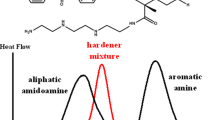Abstract
The possibilities of using tertiary amines of different structure in initiating redox systems containing benzoyl peroxide to obtain highly filled acrylic composites with a controlled rate of curing and exploitation properties in the temperature range of −25…+25°C were studied. The efficiency of the effect of each of the tertiary amines under study on the rate of low-temperature curing of composite materials was determined. The concentrations of tertiary amines required for the combination of high rates of curing and strength characteristics of composite materials were estimated. It was shown that low-temperature curing of highly filled acrylic composites is not observed in the presence of N,N-dimethyl-N-benzylamine.
Similar content being viewed by others
References
O. Figovsky and D. Beilin, Advanced Polymer Concretes and Compounds (CRC Press, Tailor & Francis Group, 2013).
V. P. Rybalko, A. I. Nikityuk, E. I. Pisarenko, et al., “High-strength fast-curing polymeric composite material,” Russ. J. Appl. Chem 87 (9), 1350–1354 (2014).
B. A. Dolgoplosk and E. I. Tinyakova, Redox Systems as Sources of Free Radicals (Nauka, Moscow, 1972) [in Russian].
E. P. Efremova, I. P. Chikhacheva, S. D. Stavrova, et al., “On the mechanism of formation of initiating radicals in the peroxide-tertiary amine system,” Vysokomol. Soedin., Ser. A 27 (3), 532–537 (1985).
S.-W. Son and J. H. Yeon, “Mechanical properties of acrylic polymer concrete containing methacrylic acid as an additive,” Constr. Build. Mater. 37, 669–679 (2012).
I. D. Sideridou, D. S. Achilias, and O. Karava, “Reactivity of benzoyl peroxide/amine system as an initiator for the free radical polymerization of dental and orthopaedic dimethacrylate monomers: Effect of the amine and monomer chemical structure,” Macromolecules 39, 2072–2080 (2006).
K.-S. Yeon, J.-Y. Cha, J. H. Yeon, and I. B. Seung, “Effects of TMPTMA and silane on the compressive strength of low-temperature cured acrylic polymer concrete,” J. Appl. Polym. Sci. 131 (20), 1–8 (2014).
K.-S. Yeon, J.-Y. Cha, and J. H. Yeon, “Effects of DMT and TMPTMA on working life of acrylic polymer concrete exposed to low curing temperatures,” Polymers 7, 1587–1598 (2015).
A. I. Nikityuk, G. I. Pidruchnyi, E. I. Pisarenko, B. I. D’yachenko, V. P. Rybalko, and V. V. Kireev, “Influence of the composition of acrylate binder on the strength of polymer composites based on it,” Plast. Massy, No. 4, 14–17 (2008).
D. S. Achilias and I. Sideridou, “Study of the effect of two BPO/amine initiation systems on the free-radical polymerization of MMA used in dental resins and bone cements,” J. Macromol. Sci., Part A: Pure Appl. Chem. A39 (12), 1435–1450 (1999).
F. F. Oldfield and H. K. Yasuda, “ESR study of MMA polymerization by a peroxide/amine system: Bone cement formation,” J. Biomed. Mater. Res. 44, 436–445 (1999).
G. M. Brauer, D. R. Steinberger, and J. W. Stansbury, “Dependence of curing time, peak temperature, and mechanical properties on the composition of bone cement,” J. Biomed. Mater. Res. 20, 839–852 (1986).
E. W. Fritsch, “Static and fatigue properties of two new low-viscosity PMMA bone cements improved by vacuum mixing,” J. Biomed. Mater. Res. 31 (4), 451–456 (1996).
A. V. Zaikina, E. I. Yarmukhamedova, Yu. I. Puzin, and Yu. B. Monakov, “Investigation of methyl methacrylate polymerization initiated by the N,N-dimethyl-N-benzylamine-benzoyl peroxide system,” Izv. Vyssh. Uchebn. Zaved., Khim. Khim. Tekhnol. 53 (3), 86–89 (2010).
A. Zoller, D. Gigmes, and Y. Guillaneuf, “Simulation of radical polymerization of methylmethacrylate at room temperature using a tertiary amine/BPO initiating system,” Polym. Chem. 6, 5719–5727 (2015).
Author information
Authors and Affiliations
Corresponding author
Additional information
Russian Text © The Author(s), 2018, published in Klei, Germetiki, Tekhnologii, 2018, No. 12, pp. 9–14.
Rights and permissions
About this article
Cite this article
Rybalko, V.P., Pisarenko, E.I., D’yachenko, P.B. et al. The Influence of the Structure of Tertiary Amines on Low-Temperature Curing of a Highly Filled Acrylic Composite Initiated with Benzoyl Peroxide. Polym. Sci. Ser. D 12, 231–235 (2019). https://doi.org/10.1134/S1995421219030201
Received:
Published:
Issue Date:
DOI: https://doi.org/10.1134/S1995421219030201



